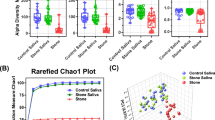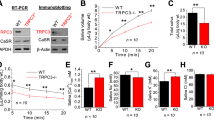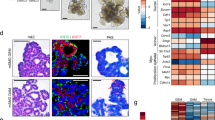Key Points
-
Salivary stones or sialoliths are calcified concrements in the salivary glands, most frequently located in Wharton's duct of the submandibular gland.
-
Salivary stones consist of a mineralised nucleus, surrounded by laminated layers of organic and inorganic substances.
-
The management of salivary stones depends on the size and location of the stone.
Abstract
Salivary stones, also known as sialoliths, are calcified concrements in the salivary glands. Sialoliths are more frequently located in the submandibular gland (84%), than in the parotid gland (13%). The majority of the submandibular stones are located in Wharton's duct (90%), whereas parotid stones are more often located in the gland itself. Salivary stones consist of an amorphous mineralised nucleus, surrounded by concentric laminated layers of organic and inorganic substances. The organic components of salivary stones include collagen, glycoproteins, amino acids and carbohydrates. The major inorganic components are hydroxyapatite, carbonate apatite, whitlockite and brushite. The management of salivary stones is focused on removing the salivary stones and preservation of salivary gland function which depends on the size and location of the stone. Conservative management of salivary stones consists of salivary gland massage and the use of sialogogues. Other therapeutic options include removal of the stone or in some cases surgical removal of the whole salivary gland.
Similar content being viewed by others
Log in or create a free account to read this content
Gain free access to this article, as well as selected content from this journal and more on nature.com
or
References
Williams M F . Sialolithiasis. Otolaryngol Clin North Am 1999; 32: 819–834.
Levy D M, Remine W H, Devine K D . Salivary gland calculi. Pain, swelling associated with eating. J Am Med Assoc 1962; 181: 1115–1119.
Zenk J, Constantinidis J, Kydles S, Hornung J, Iro H . Klinische und diagnostische Befunde bei der Sialolithiasis. HNO 1999; 47: 963–969.
Zenk J, Koch M, Klintworth N et al. Sialoendoscopy in the diagnosis and treatment of sialolithiasis: a study on more than 1000 patients. Otolaryngol Head Neck Surg 2012; 147: 858–863.
McGurk M, Escudier M P, Brown J E . Modern management of salivary calculi. Br J Surg 2005; 92: 107–112.
Pace C, Ward S . Incidental finding of sialolithiasis in the sublingual gland: a diagnostic dilemma. Dent Update 2011; 38: 704–705.
McGurk M, Escudier M P, Brown E . Modern management of obstructive salivary gland disease. Ann R Australas Coll Dent Surg 2004; 17: 45–50.
Taher A A . The incidence and composition of salivary stones (sialolithiasis) in Iran: analysis of 95 cases – a short report. Singapore Dent J 1989; 14: 33–35.
Esser R J, Zecha J J . Submandibulaire speekselstenen. Ned Tijdschr Geneeskd 1976; 120: 817–821.
Su Y X, Zhang K, Ke Z, Zheng G, Chu M, Liao G . Increased calcium and decreased magnesium and citrate concentrations of submandibular/sublingual saliva in sialolithiasis. Arch Oral Biol 2010; 55: 15–20.
Nishi M, Mimura T, Marutani K, Noikura T . Evaluation of submandibular gland function by sialo-scintigraphy following sialolithectomy. J Oral Maxillofac Surg 1987; 45: 567–571.
Anneroth G, Hansen L S . Minor salivary gland calculi: a clinical and histopathological study of forty-nine cases. Int J Oral Surg 1983; 12: 80–89.
Yamamoto H, Sakae T, Takagi M, Otake S, Hirai G . Weddelite in submandibular gland calculus J Dent Res 1983; 62: 16–19.
Marchal F, Kurt A M, Dulguerov P, Lehmann W . Retrograde theory in sialolithiasis formation. Arch Otolaryngol Head Neck Surg 2001; 127: 66–68.
Harrill J A, King J S, Boyce W H . Structure and composition of salivary calculi. Laryngoscope 1959; 59: 481–492.
Escudier M P, McGurk M . Symptomatic sialadenitis and sialolithiasis in the English population, an estimate of the cost of hospital treatment. Br Dent J 1999; 186: 463–466.
Lustmann J, Regev E, Melamed Y . Sialolithiasis. A survey on 245 patients and a review of the literature. Int J Oral Maxillofac Surg 1990; 19: 135–138.
Gupta A, Rattan D, Gupta R . Giant sialoliths of submandibular duct: report of two cases with unusual shape. Contemp Clion Dent 2013; 4: 78–80.
Blatt I M, Denning R M, Zumberge J H, Maxwell J H . Studies in sialolithiasis. I. The structure and mineralogical composition of salivary gland calculi. Ann Otol Rhinol Laryngol 1958; 67: 595–617.
Rauch S, Gorlin R J . Diseases of the salivary glands. Oral pathology 1970; 962.
Harrison J D . Causes, natural history, and incidence of salivary stones and obstructions. Otolaryngol Clin N Am 2009; 42: 927–947.
Bullock K N . Parotid and submandibular duct calculi in three successive generations of one family. Postgrad Med J 1982; 58: 35–36.
Hiraide F, Nomura Y . The fine surface structure and composition of salivary calculi. Laryngoscope 1980; 90: 152–158.
Van den Akker H P, Busemann-Sokole E . Submandibular gland function following transoral sialolithectomy. Oral Surg Oral Med Oral Pathol 1983; 56: 351–356.
Huoh K C, Eisele D W . Etiologic factors in sialolithiasis. Otolaryngol Head Neck Surg 2011; 145: 935–939.
Seldin H M, Seldin D, Rakower W . Conservative surgery for the removal of salivary calculi. Oral Surg Oral Med Oral Pathol 1953; 6: 579–587.
Pullon P A, Miller A S . Sialolithiasis of accessory salivary glands: review of fifty-five cases. J Oral Surg 1972; 30: 832–834.
Teymoortash A, Buck P, Jepsen H, Werner J A . Sialolith crystals localized intraglandularly and in the Wharton's duct of the human submandibular gland: an X-ray diffraction analysis. Arch Oral Biol 2003; 48: 233–236.
Jensen J L, Howell F V, Rick G M, Corneal R W . Minor salivary gland calculi. Oral Surg Oral Med Oral Pathol 1979; 47: 44–50.
Yamane G M, Scharlock S E, Jain R, Sundaraj M, Chaudry A P . Intra-oral minor salivary gland sialolithiasis. J Oral Med 1984; 39: 85–90.
Siddiqui S J . Sialolithiasis: an unusually large submandibular salivary stone. Br Dent J 2002; 193: 89–91.
Epivatianos A, Harrison H, Dimitriou T . Ultrastructural and histochemical observations on microcalculi in chronic submandibular sialoadenitis. Oral Pathol 1987; 16: 514–517.
Epivatianos A, Harrison J D . The presence of micro-calculi in normal human submandibular and parotid salivary glands. Arch Oral Biol 1989; 34: 261–265.
Harrison J D, Epivatianos A, Bhatia S N . Role of microliths in the aetiology of chronic submandibular sialadenitis: a clinicopathological investigation of 154 cases. Histopathology 1997; 31: 237–251.
Bodner L . Parotid sialolithiasis. J Laryngol Otol 1999; 113: 266–267.
Harrison J D . Histology and pathology of sialolithiasis. Salivary gland diseases New York, USA, Thieme, 2005: 71–78.
Mimura M, Tanaka N, Ichinose S, Kimijima Y, Amagasa T . Possible etiology of calculi formation in salivary glands: biophysical analysis of calculus. Med Mol Morphol 2005; 38: 189–195.
Triantafyllou A, Harrison J D, Garrett J R . Microliths in the parotid of ferret investigated by electron microscopy and microanalysis. Int J Exp Path 2009; 90: 439–447.
Anneroth G, Eneroth C M, Isacsson G . Crystalline structure of salivary calculi. A microradiographic and microdiffractometric study. J Oral Pathol 1975; 4: 266–272.
Lustmann J, Shteyer A . Salivary calculi: ultrastructural morphology and bacterial etiology. J Dent Res 1981; 60: 1386–1395.
Isacsson G, Hammarström L . An enzyme histochemical study of human salivary duct calculi. J Oral Pathol 1983; 12: 217–222.
Proctor G B, Osailan S M, McGurk M, Harrison J D . Sialolithiasis – pathophysiology, epidemiology and aetiology. In Nahlieli O (ed) Modern management of preserving the salivary glands. pp 91–142. Israel: Isradon Publishing House, 2007.
Anneroth G, Eneroth C M, Isacsson G, Lundquist P G . Ultrastructure of salivary calculi. Scand J Dent Res 1978; 86: 182–192.
Teymoortash A, Wollstein A C, Lippert B M, Peldszus R, Werner J A . Bacteria and pathogenesis of human salivary calculus. Acta Otolaryngol 2002; 122: 210–214.
Marchal F, Dulguerov P . Sialolithiasis management – the state of the art. Arch Otolaryngol Head Neck Surg 2003; 129: 951–956.
Kasaboglu O, Nuray E, Tümer C, Akkocaoglu M . Micromorphology of sialoliths in submandibular salivary gland: a scanning electron microscope and X-ray diffraction analysis. J Oral Maxillofac Surg 2004; 62: 1253–1258.
Zenk J, Hosemann W G, Iro H . Diameters of the main excretory ducts of the adult human submandibular and parotid gland: a histologic study. Oral Surg Oral Med Oral Pathol Oral Radiol Endod 1998; 85: 576–580.
Pollack C V, Severance H W . Sialolithiasis: case studies and review. J Emergency Med 1990; 8: 561–565.
Tanaka N, Ichinose S, Adachi Y, Mimura M, Kimijima Y . Ultrastructural analysis of salivary calculus in combination with X-ray microanalysis. Med Electron Microsc 2003; 36: 120–126.
Anneroth G, Eneroth C M, Isacsson G . Morphology of salivary calculi. The distribution of the inorganic component. J Oral Pathol 1975; 4: 257–265.
Afanas'ev V V, Tkalenko A F, Abdusalamov M R . Analysis of salivary pool composition in patients with different results of sialolithiasis treatment by sialolithotripsy. Stomatologiia 2003; 82: 36–38.
Grases F, Santiago C, Simonet B M, Costa-Bauza A . Sialolithiasis: mechanism of calculi formation and etiologic factors. Clin Chim Acta 2003; 334: 131–136.
Laforgia P D, Favia G F, Chiaravalle N, Lacaita M G, Laforgia A . Clinico-statistical, morphologic and microstructural analysis of 400 cases of sialolithiasis. Minerva Stomatol 1989; 38: 1329–1336.
Nederfors T, Nauntofte B, Twetman S . Effects of furosemide and bendroflumethiazide on saliva flow rate and composition. Arch Oral Biol 2004; 49: 507–513.
Sherman J A, McGurk M . Lack of correlation between water hardness and salivary calculi in England. Br J Oral Maxillofac Surg 2000; 38: 50–53.
Perrotta R J, Williams J R, Selfe R W . Simultaneous bilateral parotid and submandibular gland calculi. Arch Otolaryngol Head Neck Surg 1978; 104: 469–470.
Vignoles M, Faure J, Legros R, Bonel G, Guichard M . Identification of the mineral constituents of various salivary calculi by study of their thermal behavior. J Biol Buccale 1980; 8: 103–115.
Yamamoto H, Sakae T, Takagi M, Otake S . Scanning electron microscopic and X-ray microdiffractometeric studies on sialolith-crystals in human submandibular glands. Acta Pathol Jpn 1984; 34: 47–53.
Kodaka T, Debari K, Sano T, Yamada M . Scanning electron microscopy and energy-dispersive X-ray microanalysis studies of several human calculi containing calcium phosphate crystals. Scanning Microsc 1994; 8: 241–256.
Jayasree R S, Gupta A K, Vivek V, Nayar V U . Spectroscopic and thermal analysis of a submandibular sialolith of Wharton's duct resected using Nd: YAG laser. Lasers Med Sci 2008; 23: 125–131.
Slomiany B L, Murty V L N, Aono M, Slomiany A, Mandel I D . Lipid composition of the matrix of human submandibular salivary gland stones. Arch Oral Biol 1982; 27: 673–677.
Osuoji C I, Rowles S L . Studies on the organic composition of dental calculus and related calculi. Calcif Tissue Res 1974; 16: 193–200.
Slomiany B L, Murty V L N, Aono M, Slomiany A, Mandel I D . Lipid composition of human parotid salivary gland stones. J Dent Res 1983; 62: 866–869.
Proctor G B, McGurk M, Harrison J D . Protein composition of submandibular stones. J Dent Res 2005; 84(SpIss): Ab0218.
Mandel I D, Eisenstein A . Lipids in human salivary secretions and salivary calculus. Arch Oral Biol 1969; 14: 231–233.
Boskey A L, Boyan-Salyers B D, Burstein L S, Mandel I D . Lipids associated with mineralization of human submandibular gland sialoliths. Arch Oral Biol 1981; 26: 779–785.
Ekberg O, Isacsson G . Chemical analysis of the inorganic component of human salivary duct calculi. Arch Oral Biol 1981; 26: 951–953.
Hohling H J, Schöpfer H . Morphological investigations of apatite nucleation in hard tissue and salivary stone formation. Naturwissenschaften 1968; 55: 545.
Burstein L S, Boskey A L, Tannenbaum P J, Posner A S, Mandel I D . The crystal chemistry of submandibular and parotid salivary gland stones. J Oral Pathol 1979; 8: 284–291.
Szalma J, Böddi K, Lempel E et al. Structural analysis and protein identification from submandibular salivary stones. J Dent Res 2011; A391.
Whinery J . Salivary calculi. J Oral Surg 1954; 12: 43–47.
Ellies M, Laskawi R, Arglebe C, Schott A . Surgical management of nonneoplastic diseases of the submandibular gland. A follow-up study. Int J Oral Maxillofac Surg 1996; 25: 285–289.
Bodner L . Salivary gland calculi: diagnostic imaging and surgical management. Comp Contin Educ Dent 1993; 14: 572–584.
Baurmash H D . Submandibular salivary stones: current management modalities. J Oral Maxillofac Surg 2004; 62: 369–378.
McKenna J P, Bostock D J, McMenamin P G . Sialolithiasis. Am Fam Physician 1987; 36: 119–125.
Bowen M A, Tauzin M, Kluka E A, Nuss D W, DiLeo M, McWhorter A J, Schaitkin B, Walvekar R R . Diagnostic and interventional sialendoscopy: a preliminary experience. Laryngoscope 2011; 121: 299–303.
Strychowsky J E, Sommer D D, Gupta M K, Cohen N, Nahlieli O . Sialendoscopy for the management of obstructive salivary gland disease: a systematic review and meta-analysis. Arch Otolaryngol Head Neck Surg 2012; 138: 541–547.
Zenk J, Constantinidis J, Al-Kadah B, Iro H . Transoral removal of submandibular stones. Arch Otolaryngol Head Neck Surg 2001; 127: 432–436.
Zenk J, Gottwald F, Bozzato A, Iro H . Speichelsteine der Glandula submandibularis. Setinentfernung mit Organerhalt. HNO 2005; 53: 243–249.
Isacsson G, Ahlner B, Lundquist PG . Chronic sialadenitis of the submandibular gland. A retrospective study of 108 case. Arch Otorhinolaryngol 1981; 232: 91–100.
Yoshimura Y, Morishita T, Sugihara T . Salivary gland function after sialolithiasis: scintigraphic examination of submandibular glands with 99mTc-pertechnetate. J Oral Maxillofac Surg 1989; 47: 704–710.
Makdissi J, Escudier MP, Brown JE, Osailan S, Drage N, McGurk M . Glandular function after intraoral removal of salivary calculi from the hilum of the submandibular gland. Br J Oral Maxillofac Surg 2004; 42: 538–541.
Zenk J, Koch M, Mantsopoulos K, Klintworth N, Schapher M, Iro H . Der Stellenwert der extrakorporalen Stosswellen-lithotripsie bei der Therapie der Sialolithiasis. HNO 2013; 61: 306–311.
Nahlieli O, Baruchin A M . Long-term experience with endoscopic diagnosis and treatment of salivary gland inflammatory diseases. Laryngoscope 2000; 110: 988–993.
Author information
Authors and Affiliations
Corresponding author
Additional information
Refereed Paper
Rights and permissions
About this article
Cite this article
Kraaij, S., Karagozoglu, K., Forouzanfar, T. et al. Salivary stones: symptoms, aetiology, biochemical composition and treatment. Br Dent J 217, E23 (2014). https://doi.org/10.1038/sj.bdj.2014.1054
Accepted:
Published:
Issue date:
DOI: https://doi.org/10.1038/sj.bdj.2014.1054
This article is cited by
-
Proteomic analysis of sialoliths from calcified, lipid and mixed groups as a source of potential biomarkers of deposit formation in the salivary glands
Clinical Proteomics (2023)
-
Lactoferrin and the development of salivary stones: a pilot study
BioMetals (2023)
-
Sialo-cutaneous fistula with ectopic submandibular gland sialolith, revealing a hidden ipsilateral enlarged and elongated styloid process: a consideration based on CT findings
Oral Radiology (2021)
-
A comprehensive analysis of sialolith proteins and the clinical implications
Clinical Proteomics (2020)
-
Spectroscopic and Microscopic Characterisation of Parotid and Submandibular Ductal Sialoliths: A Comparative Preliminary Study
Proceedings of the National Academy of Sciences, India Section B: Biological Sciences (2020)



